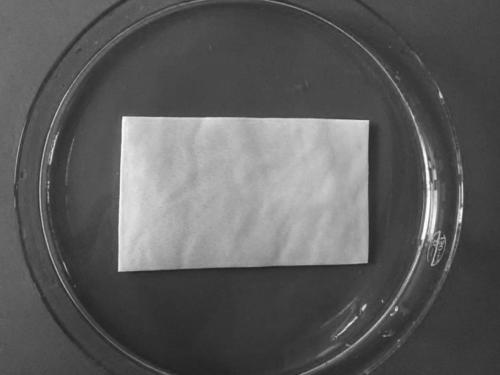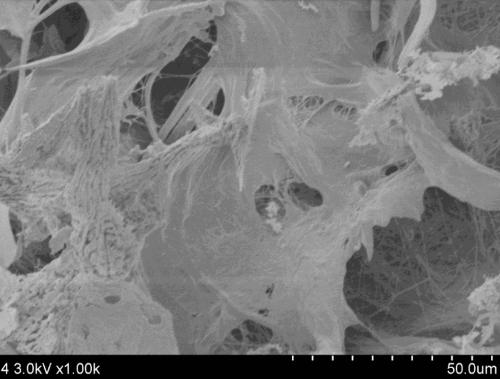Soft tissue repair patch and preparation method thereof
A soft tissue and patch technology, applied in tissue regeneration, medical science, prosthesis, etc., can solve the problems of uneven decellularization effect, incomplete cell removal, and cytotoxicity, so as to improve biocompatibility and maintain compliance Effects on Sexuality and Mechanical Properties
- Summary
- Abstract
- Description
- Claims
- Application Information
AI Technical Summary
Problems solved by technology
Method used
Image
Examples
Embodiment 1
[0051] Step 1. Preparing split skin slices: the pretreated porcine skin is removed by using a skin-taking machine to prepare split slices with a thickness ranging from 0.6 to 0.8 mm, and cleaned with purified water.
[0052] Step 2, inactivation: soak the obtained skin slices in 0.1% bromogeramine for 30 minutes for preliminary disinfection treatment.
[0053] Step 3, one-time decellularization: the first decellularization treatment was performed by using a PBS solution with a concentration of 0.125% trypsin (mass volume ratio g / 100ml) and 10mM EDTA. ℃ decellularization treatment for 6h.
[0054] Step 4, cross-linking modification: the material treated in step 3 was cross-linked and modified with an aqueous solution containing 50 mmol / L EDC, 40 mmol / L NHS, and 40 mmol / LMES, and cross-linked at room temperature for 4 hours at 25°C.
[0055] Step 5, decellularization with detergent: use PBS solution mixed with 0.5% TritonX-100 and 0.25% SDS for a second decellularization treatm...
Embodiment 2
[0061] Step 1. Preparing split skin slices: taking the pretreated cow skin by using a skinning machine, and preparing split skin slices with a thickness ranging from 0.5 to 0.7 mm. Wash well with phosphate buffered saline.
[0062] Step 2, inactivation: soak the obtained skin slices in 75% ethanol solution at room temperature for 2 hours for preliminary disinfection treatment.
[0063] Step 3. Enzymatic decellularization: use 0.1% (mass volume ratio g / 100ml) trypsin and 8mM EDTA in PBS solution for initial decellularization treatment. The treatment conditions are pretreatment at room temperature 25°C for 1 hour, and then transfer to low temperature for 6 ℃ treatment for 10h.
[0064] Step 4. Cross-linking modification: the decellularized material was modified by cross-linking with 40% ethanol solution prepared by 40mmol / L EDC, 20mmol / LNHS, and 20mmol / LMES, cross-linked at room temperature for 6h, and rinsed with PBS.
[0065] Step 5, decellularization with detergent: select ...
Embodiment 3
[0070] Step 1. Preparing split skin slices: the skin of the pretreated sheep is reversed by a skin harvester to prepare split slices with a thickness ranging from 0.8 to 1.0 mm, and cleaned with normal saline.
[0071] Step 2, inactivation: soak the obtained skin slices in 0.5% peracetic acid disinfectant for 20 minutes for preliminary disinfection treatment.
[0072] Step 3. Enzymatic decellularization: Use 0.2% (mass volume ratio g / 100ml) trypsin and 5mM EDTA in PBS solution for initial decellularization treatment. The treatment conditions are pretreatment at room temperature 25°C for 2 hours, and then transfer to low temperature 8°C for decellularization. Cells were treated for 16h.
[0073] Step 4, cross-linking modification: the decellularized material was prepared as a cross-linking solution with an aqueous solution of 30 mmol / l EDC, 20 mmol / l NHS, and 20 mmol / l MES, and cross-linked at room temperature for 5 hours.
[0074] Step 5, decellularization with detergent: use...
PUM
| Property | Measurement | Unit |
|---|---|---|
| Thickness | aaaaa | aaaaa |
| Thickness | aaaaa | aaaaa |
| Thickness | aaaaa | aaaaa |
Abstract
Description
Claims
Application Information
 Login to View More
Login to View More - R&D
- Intellectual Property
- Life Sciences
- Materials
- Tech Scout
- Unparalleled Data Quality
- Higher Quality Content
- 60% Fewer Hallucinations
Browse by: Latest US Patents, China's latest patents, Technical Efficacy Thesaurus, Application Domain, Technology Topic, Popular Technical Reports.
© 2025 PatSnap. All rights reserved.Legal|Privacy policy|Modern Slavery Act Transparency Statement|Sitemap|About US| Contact US: help@patsnap.com



